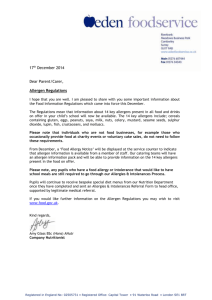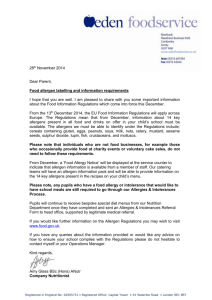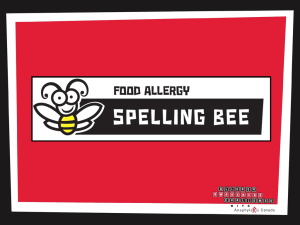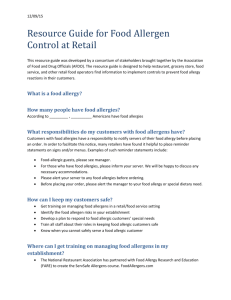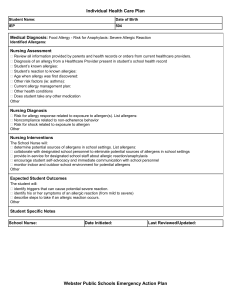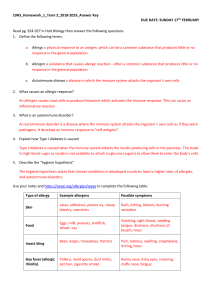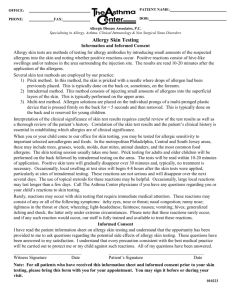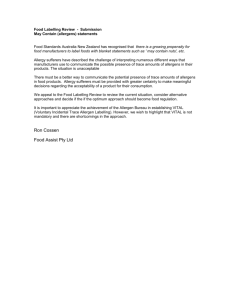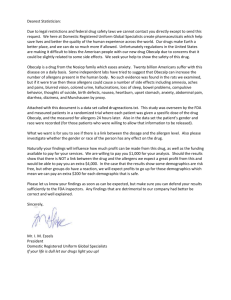Allergy, Immunology & Hypersensitivity Presentation
advertisement
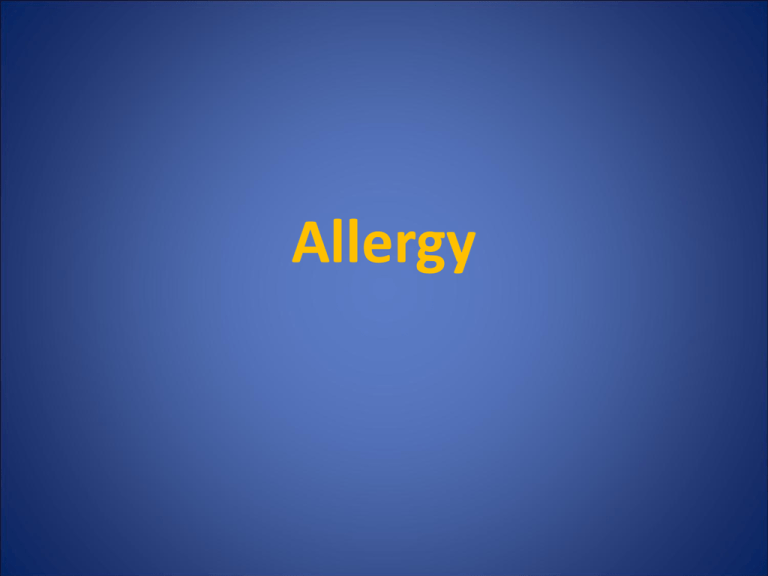
Allergy Allergies in the past • • • • • • In 4 b.c. the Greek physician Hippocrates (460BC-370 BC) noticed that particular foods, although harmless for some people, cause disease in others. Galen (AD 131-201) also wrote • about allergic reactions to some • plants, but he proposed no • explanation that phenomenon. Anaphylaxis 1902 г. Charles Richet, together with Paul Portier - Anaphylaxis 1913 г. Charles Richet received a Nobel prize for his contribution in the field of anaphylactic reactions Allergy 1906 Clemens Peter von Pirquet and Bela Schick – allergy (gr. Allos – other и ergon –reaction) Pirquet reaction – skin tuberculin scarification test, upon which Mantoux in1907 introduced a test for diagnosis of tuberculosis. Definition Pirquet, 1906 – Allergy is altered reactivity to a distinct antigen (allergen). Gell & Coombs, 1968 – Hypersensitivity due to which immunilogically induced tissue destruction develops Reactivity • Species (primary, genetically coded) • Group (population) • Gender • Age • Individual Non-specific • Specific • Physiologic • Pathologic Types of reactivity • • • • • Normergic (normergia) Hypergic (hypergia) Hyperergic (hyperergia) Anergic (anergia) Positive (effective defense mechanisms) Negative (undeveloped or “exhausted” defense mechanisms Modulating factors External (environmental) • Physical, chemical, biological • Society Constitutional (internal) • Gender • Age • Type of neural system • Profile of autonomic nervous system • Endocrine status Resistance • Natural (unreceptiveness) • Acquired (in postnatal period) • Artificially • • • • • • Active (vaccinations) Passive (serotherapy, blood transfusion) Naturally Active (disease) Passive (AB through placenta or mother’s milk Immunologic resistance Complex mechanism of defensive and • adaptive reactions • Highly specific response • Aimed against • • external (bacteria, viruses, etc.) and • internal (functionally inefficient and • mutated cells) factors. Immune response - phases • 1. Processing and presenting of the antigen • 2. Recognition of the complex МНС *- antigen with • activation of ТН lymphocyte • 3. Activation of В-cells and/or Т-cytotoxic • lymphocytes • 4. Elimination of the antigen Immune response - mechanism Stimulation of TH lymphocyte Main signal Co-stimulatory signal Immunological memory Primary Immune Response Secondary Immune Response General characteristics • Allergic reactions are typical only for homeothermic animals and men • Allergies are usually preceded by sensibilization and underlying genetic predispositionя • Allergies are immunologically mediated diseases Allergens and routes of administration • • • • • • Pollens House dust mites Goose down, wool, furs Foods Animal products Cosmetics, dyes, plastics • Medicines • Inhalant allergens • Ingestant allergens • Contactant allergens • Injected allergens Hypersensitivity - types • • • • • • Humoral type Anaphylaxis Cytotoxic reactions Immune complexes Cell-mediated type Mixed Type I – cytotropic type • • • • • • • • • • • • Explosive response - within minutes of contact with the allergen Mediated mainly by IgE Mediators of anaphylaxis Preformed Histamine Serotonin Newly created Metabolites of arachidonic acid Cytokines Atopic diseases – bronchial asthma, allergic rhinitis, urticaria etc. Type I – mechanism • • Immunologic • phase • Pathobiochemical • phase • Clinical phase Signs and symptoms in a patient with acute asthma attack Type II – Cytotoxic Antibody Reaction • • • • • • Mediated by IgG and IgM to specific antigens • Endogenous or exogenous (haptens) allergens Examples • Transfusion Reaction • Rhesus Incompatibility (Rh Incompatibility) • Mycoplasma pneumoniae related cold agglutinins • • Hashimoto' Thyroiditis • • Good pasture's Syndrome • • Delayed transplant graft rejection Type II – mechanism Type III: Immune Complex Reaction • • • • • • • • • • • • Antigen-antibody complexes deposit in tissue • Reaction within 1-3 weeks after exposure Examples – Systemic Lupus Erythematosus – Erythema Nodosum – Polyarteritis nodosa – Arthus Reaction (e.g. Farmer's Lung) – Rheumatoid Arthritis – Elephantiasis (Wuchereria bancrofti reaction) – Jarisch-Herxheimer Reaction – Serum Sickness • Localized or generalized vasculitis Type III – mechanism Type IV: Delayed-Type Hypersensitivity • • • • • • • • • Mediated by T-Lymphocytes to specific antigens – Involves major histocompatibility complex (MHC) – Reaction within 2-7 days after exposure • Examples – Mantoux Test (PPD) – Allergic Contact Dermatitis (e.g. Nickel allergy) Type IV – mechanism Contact allergies Diagnostic tests I • Skin prick test: drop of the allergen is placed on the skin and a small quantity is introduced into the skin. • Intradermal test: allergen is injected intradermally Skin prick testing Antiallergic therapy Allergen avoidance Immunotherapy Specific hyposensibilization Drug therapy Antihistamines, ʙ2 mimetics, Corticosteroids, Adrenaline
